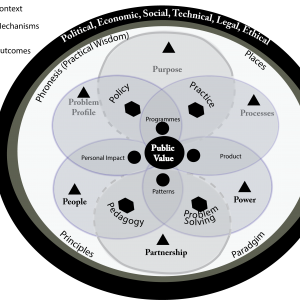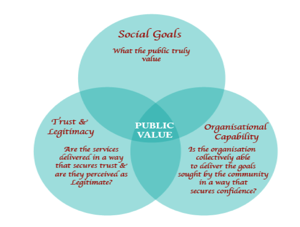Outcomes
Outcomes of New Public Leadership
Outcomes

The Oxford English Dictionary defines an outcome as “a state of affairs resulting from some process; the way something turns out; a result (of a test, experiment, measurement, etc.), a consequence; a conclusion or verdict”. It is also described as “The product, which results from an action, process, or system”.
A key element of the NPL framework is that leading in the public interest considers the creation and demonstration of public value as the outcome of effective public leadership. For this reason, the ‘P’ of public value sits at the core of the NPL framework.
Public Value

There is a wide and increasing emphasis on public value, principally through the work of Mark Moore (Moore, 1995). Public value concerns social goals, ensures that those goals are delivered in a way that secures trust and legitimacy and where organizational capability and capacity exists to deliver these goals. Trust is particularly important in securing good relationships across a range of differing contexts
The final four Ps that represent the outcomes of the NPL framework are described as follows:
The 4Ps representing the Mechanisms of NPL
Programmes are “a planned series of future events or performances; a set of related measures or activities with a particular long-term aim”. The term originates from early 17th century (in the sense of ‘written notice’). It thus helps to bridge the gap between the shared purpose (context) and policy and practice (mechanisms) in delivering public value.
A programme is a deliberate means of taking forward a course of action and each can be evaluated. Programmes can thus be viewed as a public statement of intent, with an itinerary, plan and schedule of what will be definitely undertaken
Of relevance to leadership is the meaning of ‘patterns’ as “an arrangement or design regularly found in comparable objects; a regular and intelligible form or sequence discernible in the way in which something happens or is done …… a model or design or an excellent example for others to follow”. Everything that we do, and everything that we see, is determined by patterns. This is represented by what is described as the intelligent leadership process.
A further outcome of effective public leadership is that of ‘personal impact’. As we know, traditional leadership theory and language has tended to focus on the individual whereas public leadership focuses more on the collective. However, the individual lies at the heart of collective activity and another aspect of collective leadership is that of relationships. The concept of performance traditionally holds more weight when considered within the individual domain as opposed to the collective (patterns and products). The difficulty is in the assessment of performance of individuals to the prevailing patterns or products/service outcomes.
A product is defined as “an article or substance that is manufactured or a thing or person that is the result of an action or process”(for example, an outcome from a particular mechanism). In terms of leadership within the not-for-profit sectors, the product is likely to be more about the result of an action or process rather then it’s production, as opposed to manufacturing where the product is likely to be a tangible and visible outcome. But there are no clear rules and there is no ‘barbed wire’ around outcomes whether as services or products.
Being ‘fit for purpose’ is one of the ways of defining quality, and this is a good starting point in understanding the common denominators between physical products and less visible services. The origins of the word quality go back to Anglo-Norman and Old French, qualité (of things), an attribute or property. It can represent a personal attribute, a trait or a feature of a person’s character, an attribute considered desirable and, interestingly, a virtue. In terms of non-personal attributes, it relates to the “standard or nature of something as measured against other things of a similar kind; the degree of excellence possessed by a thing”.
Quality thus relates to both personal disposition, as well as actions taken and highlights the importance of balanced performance measures. This aligns and supports the core ‘P’, which is that of public value representing the all-embracing outcome of leading in the public interest.